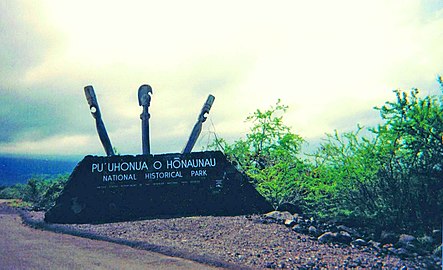Pu'uhonua O Honaunau National Historical Park
Puʻuhonua o Hōnaunau is one of the only four places in Hawaii where the flag of Hawaii can officially fly alone without the American flag; the other three places are ʻIolani Palace, the Mauna ʻAla and Thomas Square.
Park name and features
The 420 acre (1.7 km) site was originally established in 1955 as City of Refuge National Historical Park and was renamed on November 10, 1978. In 2000 the name was changed by the Hawaiian National Park Language Correction Act of 2000 observing the Hawaiian spelling. It includes the puʻuhonua and a complex of archeological sites including: temple platforms, royal fishponds, sledding tracks, and some coastal village sites. The Hale o Keawe temple and several thatched structures have been reconstructed.
Hale o Keawe heiau

Hale o Keawe was an ancient Hawaiian heiau originally built in approximately 1650 AD as the burial site for the ruling monarch (aliʻi nui) of the Island of Hawaii named Keaweʻīkekahialiʻiokamoku. It was built by his son, a Kona chief named Kanuha. The complex may have been established as early as 1475 under the aliʻi nui ʻEhu-kai-malino. The nobility (ali'i) of Kona continued to be buried until the abolition of the kapu system. The last person buried here was a son of Kamehameha I in 1818.
Radiocarbon dating has not been done extensively in the area. Testing of the nearby 'Āle'ale'a heiau site gave deceptive results. Oral traditions compiled by Dorothy Barrère are still considered the best for chronological order of the surrounding complex.
The heiau contained 23 remains including that of Keaweʻīkekahialiʻiokamoku. It was situated near a great ancient wall near the royal residence to the east side of the wall. Further south were further aliʻi homes were built. Excavations of the area indicate a large crafting community to support the royal residence. The heiau would lay untouched after the banning of the Hawaiian religion while all other such temples were destroyed until Kaahumanu had the building dismantled and all the remains moved to the royal mausoleum in Honolulu.
It was believed that additional protection to the place of refuge was received from the mana in the bones of the chiefs. It survived several years after other temples were destroyed. It was looted by Lord George Byron (cousin of the distinguished English poet) in 1825. In 1829, High Chiefess Kapiʻolani removed the remaining bones and hid them in the Pali Kapu O Keōua cliffs above nearby Kealakekua Bay. She then ordered this last temple to be destroyed. The bones were later moved to the Royal Mausoleum of Hawaii in 1858.
The heiau in the park was reconstructed in the 1960s.
-
The entrance to the park.
-
Hawaiian hale (house) at the Puʻuhonua o Hōnaunau National Historical Park.
-
Protector kii (statues) at the Place of Refuge.
See also
References
- ^ "Geology of Puʻuhonua o Hōnaunau National Historical Park". www.usgs.gov. Retrieved September 13, 2022.
- ^ "National Park Service Visitor Use Statistics". National Park Service. Retrieved April 26, 2017.
- ^ Clark, John (2019). "The Kamehameha III Statue in Thomas Square". The Hawaiian Journal of History. 53. Honolulu: Hawaiian Historical Society: 147–149. doi:10.1353/hjh.2019.0008. ISSN 2169-7639. OCLC 60626541. S2CID 214511964.
- ^ Fuller, Landry (August 2, 2016). "Flying high". West Hawaii Today. Kailua-Kona: Oahu Publications, Inc. Retrieved April 1, 2020.
- ^ "Hawaiian National Park Language Correction Act of 2000 (S.939)" (PDF). Govtrack.us. Retrieved July 28, 2017.
- ^ Patrick Vinton Kirch (1997). Feathered Gods and Fishhooks: An Introduction to Hawaiian Archaeology and Prehistory. University of Hawaii Press. p. 162. ISBN 978-0-8248-1938-5.
- ^ Pu'uhonua-o-Honaunau, City of Refuge National Historic Park, Natural and Cultural Resources Management Plan and Environmental Assessment (EA). 1976. pp. 25–26.
- ^ Ala Kahakai National Trail, Hawaii County: Environmental Impact Statement. 1998. p. 1.
- ^ Patrick Vinton Kirch (1996). Legacy of the Landscape: An Illustrated Guide to Hawaiian Archaeological Sites. University of Hawaii Press. p. 46. ISBN 978-0-8248-1739-8.
- ^ Patrick Vinton Kirch (December 2, 2010). How Chiefs Became Kings: Divine Kingship and the Rise of Archaic States in Ancient Hawai'i. University of California Press. p. 169. ISBN 978-0-520-26725-1.
- ^ Robert F. Oaks (November 1, 2003). Hawai'i: A History of the Big Island. Arcadia Publishing. p. 22. ISBN 978-1-4396-1403-7.
- ^ Rowland Bloxam (1920). "Visit of H.M.S. Blonde to Hawaii in 1825". All About Hawaii: Thrum's Hawaiian Annual and Standard Guide. Thomas G. Thrum, Honolulu: 66–82.
- ^ Alexander, William DeWitt (1894). "The "Hale o Keawe" at Honaunau, Hawaii". Journal of the Polynesian Society. 3. London: E. A. Petherick: 159–161.
- ^ "Hale o Keawe - Puʻuhonua o Hōnaunau National Historical Park (U.S. National Park Service)". www.nps.gov. Retrieved November 6, 2021.
- Ward, Greg. 2004, The Rough Guide to Hawaii. Rough Guides.
External links
| External videos | |
|---|---|
 Puʻuhonua o Hōnaunau National Historical Park travel guide from Wikivoyage
Puʻuhonua o Hōnaunau National Historical Park travel guide from Wikivoyage- Pu`uhonua o Honaunau National Historical Park – National Park Service official site
- U.S. Geological Survey Geographic Names Information System: Puʻuhonua o Hōnaunau National Historical Park
- Photo essay on residences of Hawaiian Kings
- Go Hawaii article about the park with photos(archived)
- Photographs of the reflecting pools at Pu`uhonua o Honaunau National Historical Park *Broken Link*



